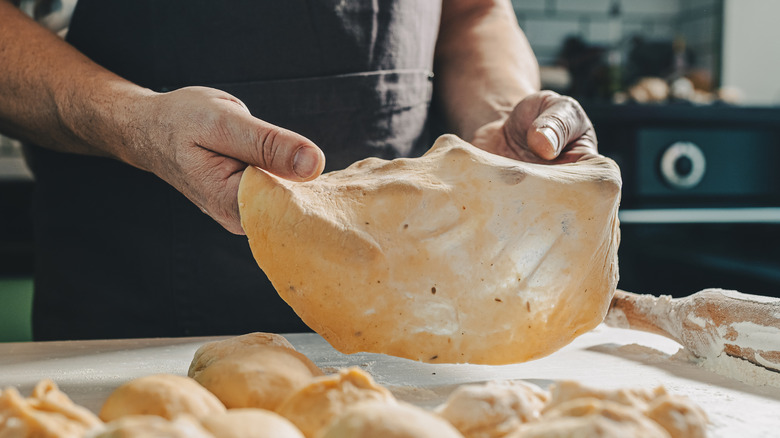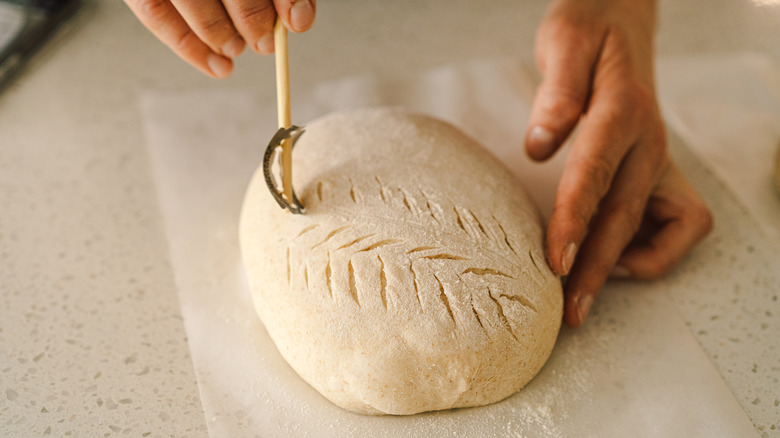What You Need To Know About Strong Flour And When To Use It In Your Bakes
If you've ever come across a recipe that calls for "strong flour," you might've found yourself at a loss. Strong flour isn't a widely used term stateside, so Americans most likely won't find it in stores. But what is strong flour? And what should you use as a substitute? The Takeout asked Ed McCormick, founder of Cape Crystal Brands, to explain. According to McCormick, strong flour is pretty much the same thing as the bread flour you see on supermarket shelves.
"Bread flour is actually a type of strong flour with a high protein content and specially formulated for bread making," McCormick said. " ... Bread flour usually has 12 to 14% protein content, which is just a little higher than the average all-purpose flour." The terms are largely regional. Brits call high-protein flour "strong flour," while Americans know it as "bread flour." The United States Department of Agriculture recognises the term "bread flour" or "high gluten flour" for flour with a high protein content, but "strong flour" isn't on the list. You may also see high-protein flour referred to as "hard wheat flour."
Bread flour isn't necessarily exactly equivalent to the strong flour British bakers use, though. The U.S. and the U.K. have different methods for measuring protein content in flour, so 13% protein has a different meaning across the pond. The method used in the U.S. tends to produce higher numbers — something to keep in mind when using recipes that recommend a specific protein content.
What makes strong flour strong?
When you think of the kind of food someone who wants to build muscle would eat, you typically think of protein. Protein makes strong flour strong, too. Flour contains two important types of protein, glutenin and gliadin. When you mix flour with liquid, the two proteins connect to form gluten. Think of gluten as the muscle that holds your bread together. Protein strengthens that muscle, just as it would in your own body. The higher the protein content, the more gluten you'll get — and the stronger and stretchier your dough will be.
Most wheat falls into one of two categories: hard wheat and soft wheat. Hard wheat, the type used to make strong flour, has the highest protein content. "Strong flour, or hard wheat or high-protein, is flour that contains more gluten than soft wheat flours," Ed McCormick explained. " [...] This gives it its strength to provide structure in some types of baked goods that require greater stretch, like bread."
That structure and stretch help hold the dough together and form the bubbles that make bread rise, which is why you'll need stretchy binders like xanthan gum for gluten-free bakes. High protein content doesn't always translate to a strong gluten structure, though. Even though whole wheat flour is often made from hard wheat, it won't form much gluten because the wheat berry's bran and germ affect the gluten structure. "Strong flour's selling points lie in its ability to yield doughs with a firm, elastic texture, making it perfect for products that need to rise well and retain their shape," said McCormick.
What should you use strong flour for?
Can you ever substitute all-purpose flour for strong flour? Sometimes yes, sometimes no. "Strong flour is better suited to dough that needs this proofing and shaping time, such as sourdough, pizza base dough, baguettes, or indeed any other yeast-raised recipe," Ed McCormick explained. "The increased protein will form more gluten, leading to a denser and chewier texture ... more so than you would get with all-purpose flour."
It's important to use strong flour for any recipe that needs extra structure, like "high-hydration doughs and recipes with a greater fermentation," according to McCormick. Since high-hydration dough contains more water, the gluten needs to work harder to keep the dough together. Extra protein isn't always a good thing, though. Avoid using strong flour for cakes and other non-yeasted baked goods. The overdeveloped gluten will leave you with a gummy, dense texture. That said, you might want to use cake flour for breads with a cake-like texture, like milk bread, or bread flour cakes with a bread-like texture, like pound cake.
If you understand the role of strong flour, you'll be better able to make decisions on when and where to use it. If you do need to substitute all-purpose flour for strong flour, slightly reduce the amount of water in your recipe. Keep your expectations in check, too — don't expect a sky-high rise if you substitute all-purpose flour in a recipe that calls for the strong stuff.


